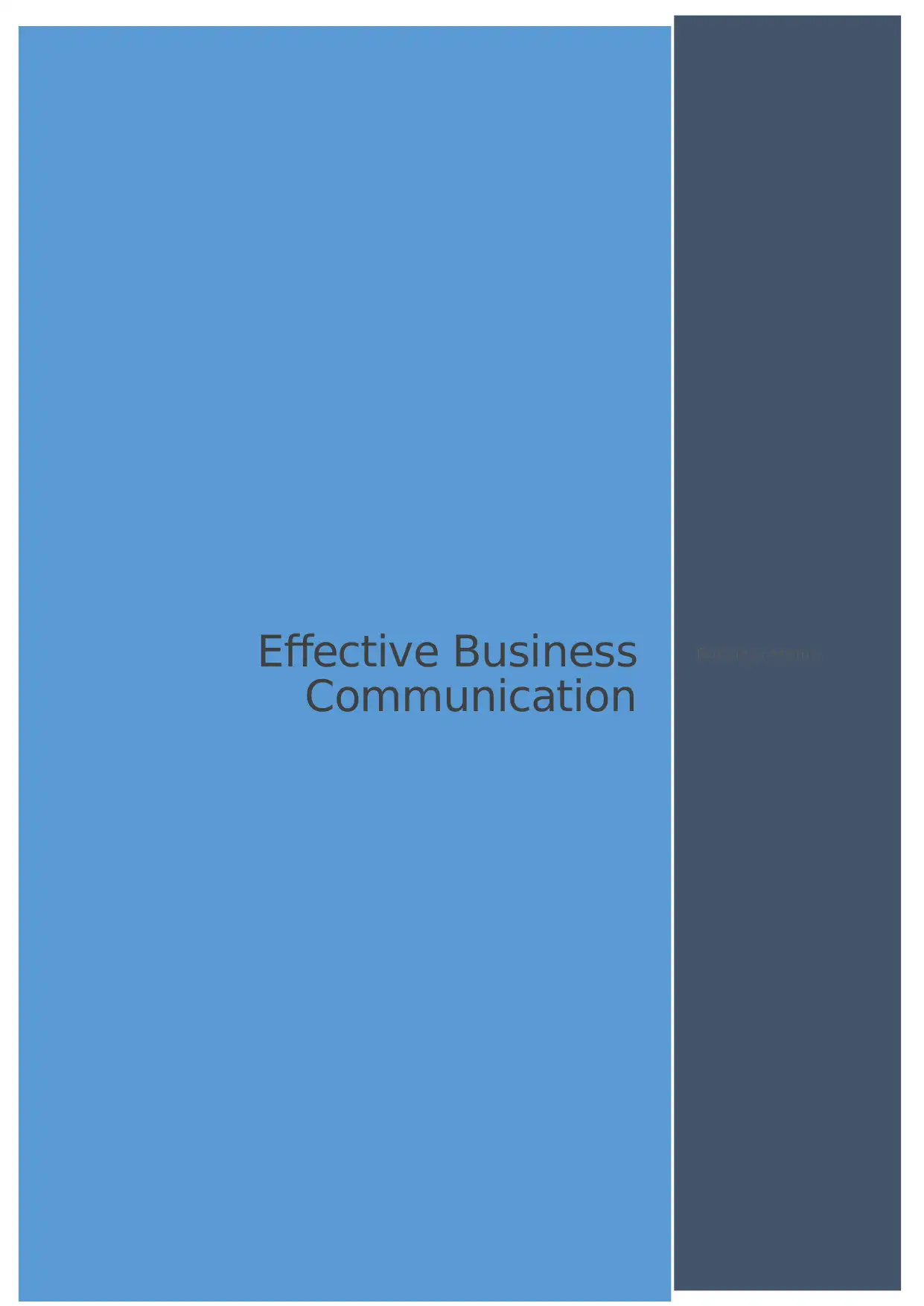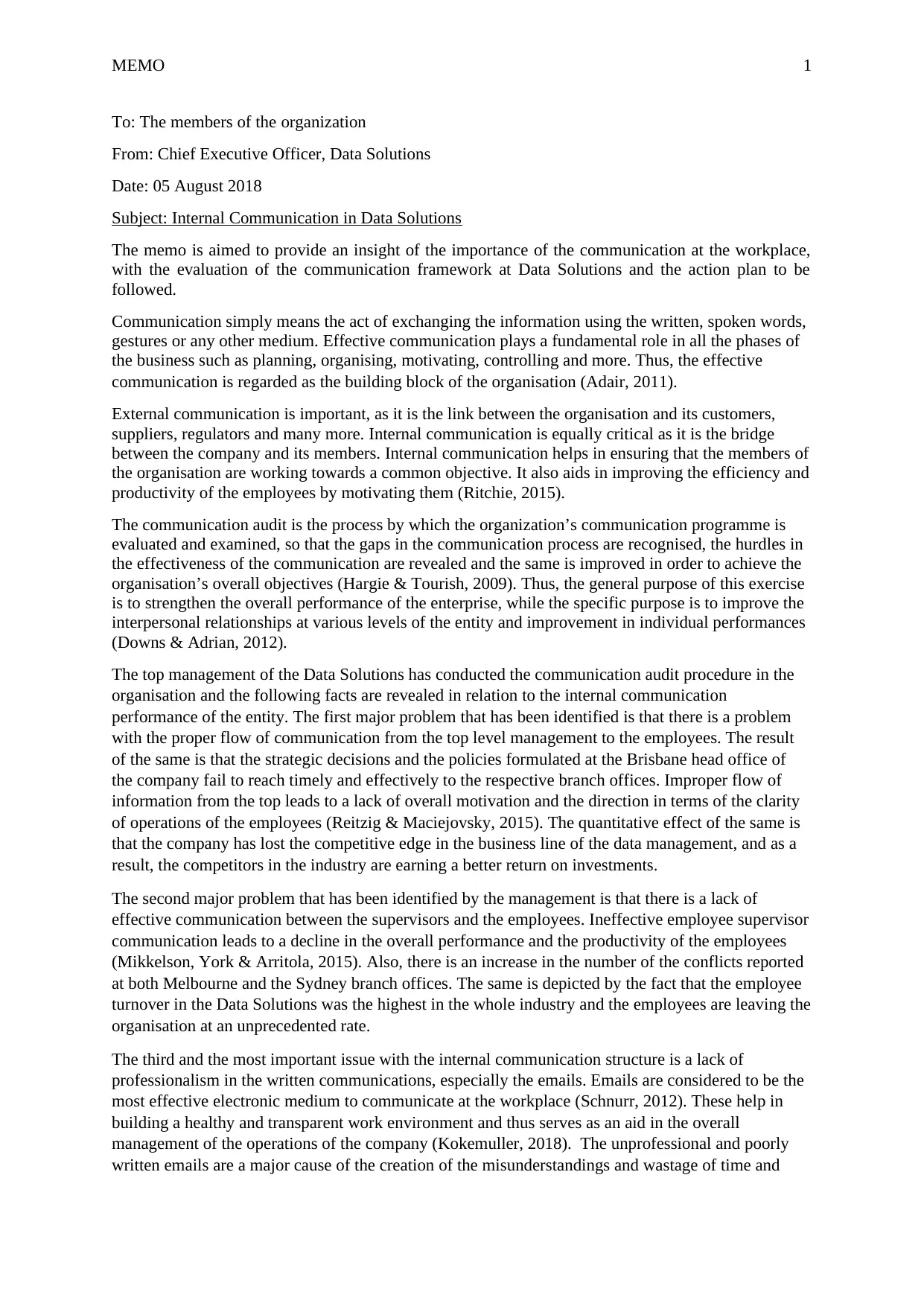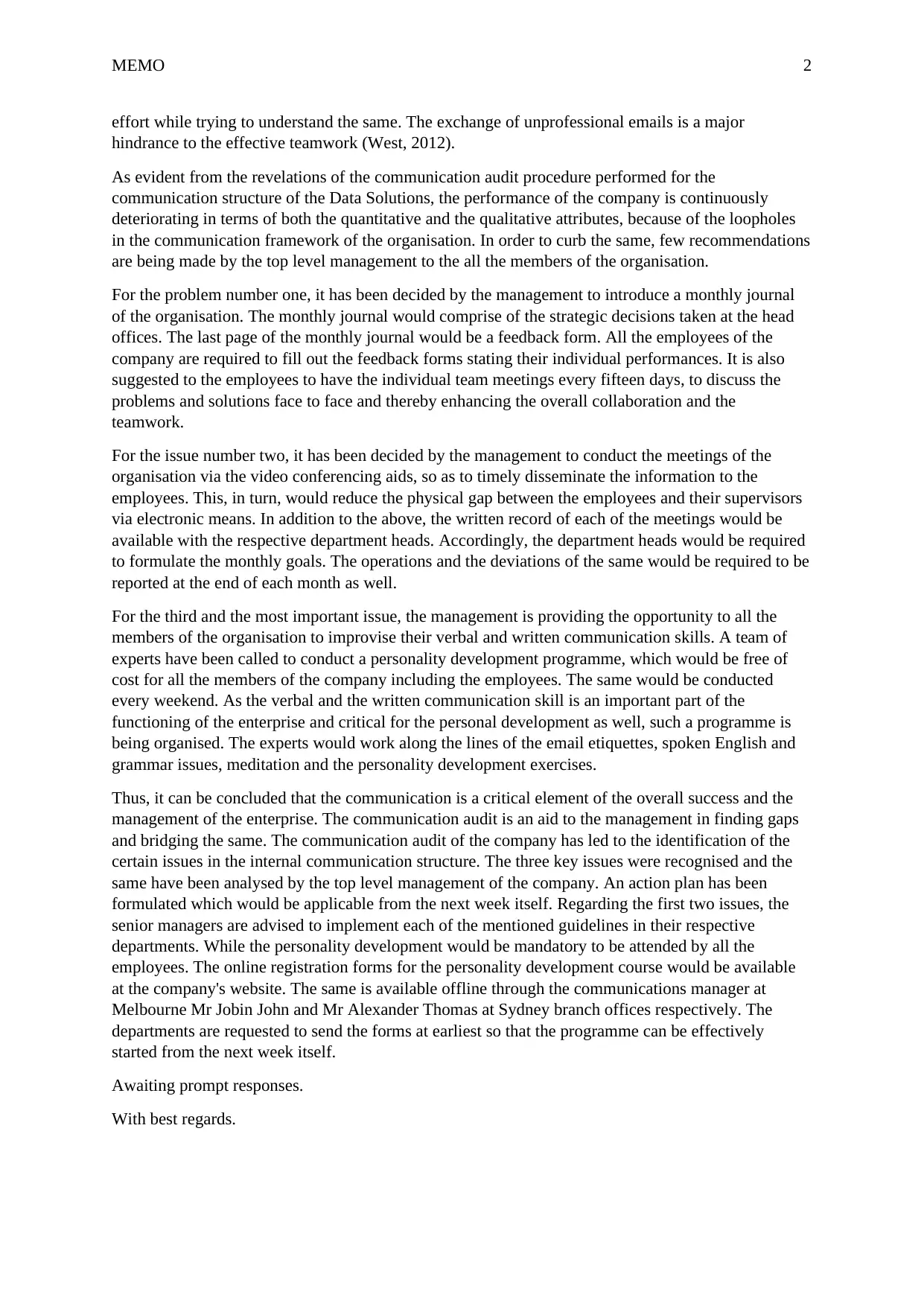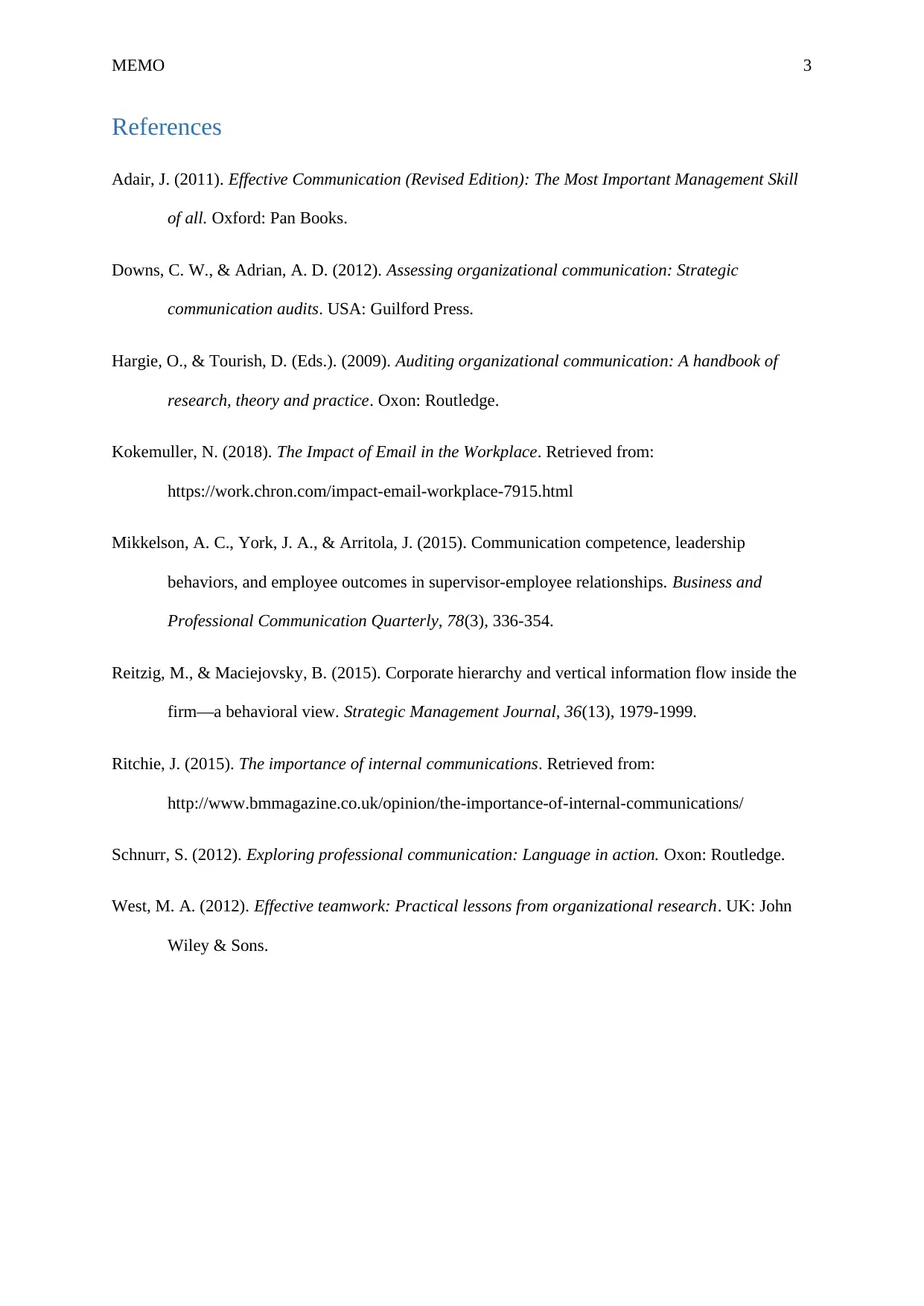Evaluation of Effective Business Communication at Data Solutions
VerifiedAdded on 2023/06/10
|4
|1638
|414
Report
AI Summary
This report analyzes a business memo from Data Solutions, focusing on the importance of effective internal communication within the organization. The memo, addressed to the organization's members from the CEO, evaluates the current communication framework and proposes an action plan to address identified issues. The report highlights problems such as ineffective information flow from top management, poor supervisor-employee communication, and unprofessional written communication, particularly in emails. The proposed solutions include a monthly journal, team meetings via video conferencing, and a personality development program for employees. The communication audit revealed that these issues negatively impact the company's performance, both quantitatively and qualitatively, and the report concludes with the recommendations for improvement. The action plan is designed to be implemented immediately, with senior managers responsible for departmental implementation and mandatory employee participation in the personality development program. This comprehensive analysis of the memo provides valuable insights into communication strategies and their impact on organizational success.

Effective Business
Communication
Business Memo
Communication
Business Memo
Paraphrase This Document
Need a fresh take? Get an instant paraphrase of this document with our AI Paraphraser

MEMO 1
To: The members of the organization
From: Chief Executive Officer, Data Solutions
Date: 05 August 2018
Subject: Internal Communication in Data Solutions
The memo is aimed to provide an insight of the importance of the communication at the workplace,
with the evaluation of the communication framework at Data Solutions and the action plan to be
followed.
Communication simply means the act of exchanging the information using the written, spoken words,
gestures or any other medium. Effective communication plays a fundamental role in all the phases of
the business such as planning, organising, motivating, controlling and more. Thus, the effective
communication is regarded as the building block of the organisation (Adair, 2011).
External communication is important, as it is the link between the organisation and its customers,
suppliers, regulators and many more. Internal communication is equally critical as it is the bridge
between the company and its members. Internal communication helps in ensuring that the members of
the organisation are working towards a common objective. It also aids in improving the efficiency and
productivity of the employees by motivating them (Ritchie, 2015).
The communication audit is the process by which the organization’s communication programme is
evaluated and examined, so that the gaps in the communication process are recognised, the hurdles in
the effectiveness of the communication are revealed and the same is improved in order to achieve the
organisation’s overall objectives (Hargie & Tourish, 2009). Thus, the general purpose of this exercise
is to strengthen the overall performance of the enterprise, while the specific purpose is to improve the
interpersonal relationships at various levels of the entity and improvement in individual performances
(Downs & Adrian, 2012).
The top management of the Data Solutions has conducted the communication audit procedure in the
organisation and the following facts are revealed in relation to the internal communication
performance of the entity. The first major problem that has been identified is that there is a problem
with the proper flow of communication from the top level management to the employees. The result
of the same is that the strategic decisions and the policies formulated at the Brisbane head office of
the company fail to reach timely and effectively to the respective branch offices. Improper flow of
information from the top leads to a lack of overall motivation and the direction in terms of the clarity
of operations of the employees (Reitzig & Maciejovsky, 2015). The quantitative effect of the same is
that the company has lost the competitive edge in the business line of the data management, and as a
result, the competitors in the industry are earning a better return on investments.
The second major problem that has been identified by the management is that there is a lack of
effective communication between the supervisors and the employees. Ineffective employee supervisor
communication leads to a decline in the overall performance and the productivity of the employees
(Mikkelson, York & Arritola, 2015). Also, there is an increase in the number of the conflicts reported
at both Melbourne and the Sydney branch offices. The same is depicted by the fact that the employee
turnover in the Data Solutions was the highest in the whole industry and the employees are leaving the
organisation at an unprecedented rate.
The third and the most important issue with the internal communication structure is a lack of
professionalism in the written communications, especially the emails. Emails are considered to be the
most effective electronic medium to communicate at the workplace (Schnurr, 2012). These help in
building a healthy and transparent work environment and thus serves as an aid in the overall
management of the operations of the company (Kokemuller, 2018). The unprofessional and poorly
written emails are a major cause of the creation of the misunderstandings and wastage of time and
To: The members of the organization
From: Chief Executive Officer, Data Solutions
Date: 05 August 2018
Subject: Internal Communication in Data Solutions
The memo is aimed to provide an insight of the importance of the communication at the workplace,
with the evaluation of the communication framework at Data Solutions and the action plan to be
followed.
Communication simply means the act of exchanging the information using the written, spoken words,
gestures or any other medium. Effective communication plays a fundamental role in all the phases of
the business such as planning, organising, motivating, controlling and more. Thus, the effective
communication is regarded as the building block of the organisation (Adair, 2011).
External communication is important, as it is the link between the organisation and its customers,
suppliers, regulators and many more. Internal communication is equally critical as it is the bridge
between the company and its members. Internal communication helps in ensuring that the members of
the organisation are working towards a common objective. It also aids in improving the efficiency and
productivity of the employees by motivating them (Ritchie, 2015).
The communication audit is the process by which the organization’s communication programme is
evaluated and examined, so that the gaps in the communication process are recognised, the hurdles in
the effectiveness of the communication are revealed and the same is improved in order to achieve the
organisation’s overall objectives (Hargie & Tourish, 2009). Thus, the general purpose of this exercise
is to strengthen the overall performance of the enterprise, while the specific purpose is to improve the
interpersonal relationships at various levels of the entity and improvement in individual performances
(Downs & Adrian, 2012).
The top management of the Data Solutions has conducted the communication audit procedure in the
organisation and the following facts are revealed in relation to the internal communication
performance of the entity. The first major problem that has been identified is that there is a problem
with the proper flow of communication from the top level management to the employees. The result
of the same is that the strategic decisions and the policies formulated at the Brisbane head office of
the company fail to reach timely and effectively to the respective branch offices. Improper flow of
information from the top leads to a lack of overall motivation and the direction in terms of the clarity
of operations of the employees (Reitzig & Maciejovsky, 2015). The quantitative effect of the same is
that the company has lost the competitive edge in the business line of the data management, and as a
result, the competitors in the industry are earning a better return on investments.
The second major problem that has been identified by the management is that there is a lack of
effective communication between the supervisors and the employees. Ineffective employee supervisor
communication leads to a decline in the overall performance and the productivity of the employees
(Mikkelson, York & Arritola, 2015). Also, there is an increase in the number of the conflicts reported
at both Melbourne and the Sydney branch offices. The same is depicted by the fact that the employee
turnover in the Data Solutions was the highest in the whole industry and the employees are leaving the
organisation at an unprecedented rate.
The third and the most important issue with the internal communication structure is a lack of
professionalism in the written communications, especially the emails. Emails are considered to be the
most effective electronic medium to communicate at the workplace (Schnurr, 2012). These help in
building a healthy and transparent work environment and thus serves as an aid in the overall
management of the operations of the company (Kokemuller, 2018). The unprofessional and poorly
written emails are a major cause of the creation of the misunderstandings and wastage of time and

MEMO 2
effort while trying to understand the same. The exchange of unprofessional emails is a major
hindrance to the effective teamwork (West, 2012).
As evident from the revelations of the communication audit procedure performed for the
communication structure of the Data Solutions, the performance of the company is continuously
deteriorating in terms of both the quantitative and the qualitative attributes, because of the loopholes
in the communication framework of the organisation. In order to curb the same, few recommendations
are being made by the top level management to the all the members of the organisation.
For the problem number one, it has been decided by the management to introduce a monthly journal
of the organisation. The monthly journal would comprise of the strategic decisions taken at the head
offices. The last page of the monthly journal would be a feedback form. All the employees of the
company are required to fill out the feedback forms stating their individual performances. It is also
suggested to the employees to have the individual team meetings every fifteen days, to discuss the
problems and solutions face to face and thereby enhancing the overall collaboration and the
teamwork.
For the issue number two, it has been decided by the management to conduct the meetings of the
organisation via the video conferencing aids, so as to timely disseminate the information to the
employees. This, in turn, would reduce the physical gap between the employees and their supervisors
via electronic means. In addition to the above, the written record of each of the meetings would be
available with the respective department heads. Accordingly, the department heads would be required
to formulate the monthly goals. The operations and the deviations of the same would be required to be
reported at the end of each month as well.
For the third and the most important issue, the management is providing the opportunity to all the
members of the organisation to improvise their verbal and written communication skills. A team of
experts have been called to conduct a personality development programme, which would be free of
cost for all the members of the company including the employees. The same would be conducted
every weekend. As the verbal and the written communication skill is an important part of the
functioning of the enterprise and critical for the personal development as well, such a programme is
being organised. The experts would work along the lines of the email etiquettes, spoken English and
grammar issues, meditation and the personality development exercises.
Thus, it can be concluded that the communication is a critical element of the overall success and the
management of the enterprise. The communication audit is an aid to the management in finding gaps
and bridging the same. The communication audit of the company has led to the identification of the
certain issues in the internal communication structure. The three key issues were recognised and the
same have been analysed by the top level management of the company. An action plan has been
formulated which would be applicable from the next week itself. Regarding the first two issues, the
senior managers are advised to implement each of the mentioned guidelines in their respective
departments. While the personality development would be mandatory to be attended by all the
employees. The online registration forms for the personality development course would be available
at the company's website. The same is available offline through the communications manager at
Melbourne Mr Jobin John and Mr Alexander Thomas at Sydney branch offices respectively. The
departments are requested to send the forms at earliest so that the programme can be effectively
started from the next week itself.
Awaiting prompt responses.
With best regards.
effort while trying to understand the same. The exchange of unprofessional emails is a major
hindrance to the effective teamwork (West, 2012).
As evident from the revelations of the communication audit procedure performed for the
communication structure of the Data Solutions, the performance of the company is continuously
deteriorating in terms of both the quantitative and the qualitative attributes, because of the loopholes
in the communication framework of the organisation. In order to curb the same, few recommendations
are being made by the top level management to the all the members of the organisation.
For the problem number one, it has been decided by the management to introduce a monthly journal
of the organisation. The monthly journal would comprise of the strategic decisions taken at the head
offices. The last page of the monthly journal would be a feedback form. All the employees of the
company are required to fill out the feedback forms stating their individual performances. It is also
suggested to the employees to have the individual team meetings every fifteen days, to discuss the
problems and solutions face to face and thereby enhancing the overall collaboration and the
teamwork.
For the issue number two, it has been decided by the management to conduct the meetings of the
organisation via the video conferencing aids, so as to timely disseminate the information to the
employees. This, in turn, would reduce the physical gap between the employees and their supervisors
via electronic means. In addition to the above, the written record of each of the meetings would be
available with the respective department heads. Accordingly, the department heads would be required
to formulate the monthly goals. The operations and the deviations of the same would be required to be
reported at the end of each month as well.
For the third and the most important issue, the management is providing the opportunity to all the
members of the organisation to improvise their verbal and written communication skills. A team of
experts have been called to conduct a personality development programme, which would be free of
cost for all the members of the company including the employees. The same would be conducted
every weekend. As the verbal and the written communication skill is an important part of the
functioning of the enterprise and critical for the personal development as well, such a programme is
being organised. The experts would work along the lines of the email etiquettes, spoken English and
grammar issues, meditation and the personality development exercises.
Thus, it can be concluded that the communication is a critical element of the overall success and the
management of the enterprise. The communication audit is an aid to the management in finding gaps
and bridging the same. The communication audit of the company has led to the identification of the
certain issues in the internal communication structure. The three key issues were recognised and the
same have been analysed by the top level management of the company. An action plan has been
formulated which would be applicable from the next week itself. Regarding the first two issues, the
senior managers are advised to implement each of the mentioned guidelines in their respective
departments. While the personality development would be mandatory to be attended by all the
employees. The online registration forms for the personality development course would be available
at the company's website. The same is available offline through the communications manager at
Melbourne Mr Jobin John and Mr Alexander Thomas at Sydney branch offices respectively. The
departments are requested to send the forms at earliest so that the programme can be effectively
started from the next week itself.
Awaiting prompt responses.
With best regards.
⊘ This is a preview!⊘
Do you want full access?
Subscribe today to unlock all pages.

Trusted by 1+ million students worldwide

MEMO 3
References
Adair, J. (2011). Effective Communication (Revised Edition): The Most Important Management Skill
of all. Oxford: Pan Books.
Downs, C. W., & Adrian, A. D. (2012). Assessing organizational communication: Strategic
communication audits. USA: Guilford Press.
Hargie, O., & Tourish, D. (Eds.). (2009). Auditing organizational communication: A handbook of
research, theory and practice. Oxon: Routledge.
Kokemuller, N. (2018). The Impact of Email in the Workplace. Retrieved from:
https://work.chron.com/impact-email-workplace-7915.html
Mikkelson, A. C., York, J. A., & Arritola, J. (2015). Communication competence, leadership
behaviors, and employee outcomes in supervisor-employee relationships. Business and
Professional Communication Quarterly, 78(3), 336-354.
Reitzig, M., & Maciejovsky, B. (2015). Corporate hierarchy and vertical information flow inside the
firm—a behavioral view. Strategic Management Journal, 36(13), 1979-1999.
Ritchie, J. (2015). The importance of internal communications. Retrieved from:
http://www.bmmagazine.co.uk/opinion/the-importance-of-internal-communications/
Schnurr, S. (2012). Exploring professional communication: Language in action. Oxon: Routledge.
West, M. A. (2012). Effective teamwork: Practical lessons from organizational research. UK: John
Wiley & Sons.
References
Adair, J. (2011). Effective Communication (Revised Edition): The Most Important Management Skill
of all. Oxford: Pan Books.
Downs, C. W., & Adrian, A. D. (2012). Assessing organizational communication: Strategic
communication audits. USA: Guilford Press.
Hargie, O., & Tourish, D. (Eds.). (2009). Auditing organizational communication: A handbook of
research, theory and practice. Oxon: Routledge.
Kokemuller, N. (2018). The Impact of Email in the Workplace. Retrieved from:
https://work.chron.com/impact-email-workplace-7915.html
Mikkelson, A. C., York, J. A., & Arritola, J. (2015). Communication competence, leadership
behaviors, and employee outcomes in supervisor-employee relationships. Business and
Professional Communication Quarterly, 78(3), 336-354.
Reitzig, M., & Maciejovsky, B. (2015). Corporate hierarchy and vertical information flow inside the
firm—a behavioral view. Strategic Management Journal, 36(13), 1979-1999.
Ritchie, J. (2015). The importance of internal communications. Retrieved from:
http://www.bmmagazine.co.uk/opinion/the-importance-of-internal-communications/
Schnurr, S. (2012). Exploring professional communication: Language in action. Oxon: Routledge.
West, M. A. (2012). Effective teamwork: Practical lessons from organizational research. UK: John
Wiley & Sons.
1 out of 4
Related Documents
Your All-in-One AI-Powered Toolkit for Academic Success.
+13062052269
info@desklib.com
Available 24*7 on WhatsApp / Email
![[object Object]](/_next/static/media/star-bottom.7253800d.svg)
Unlock your academic potential
Copyright © 2020–2025 A2Z Services. All Rights Reserved. Developed and managed by ZUCOL.


